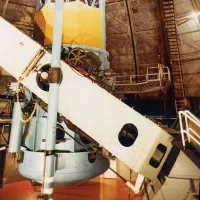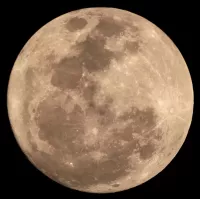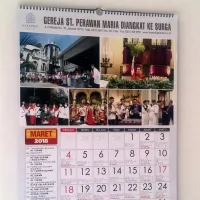A blue moon is defined in several ways: most commonly, it's the second full moon within a single calendar month. Alternatively, it can refer to the third full moon in a season that has four full moons. In rare cases, the moon may visually appear blue due to specific atmospheric conditions, though this is unrelated to the calendrical definitions. The term is mostly used in the context of the first two definitions related to the lunar cycle.
July 11, 1911: Robert Falcon Scott's Diary
On July 11, 1911, Robert Falcon Scott's Antarctic diary mentioned "the air thick with snow, and the moon a vague blue".
1934: Three blue moons in 1934
In 1934, there were three blue moons (one of each type).
1937: Introduction of the term blue moon
In 1937, H.P. Trefethen introduced the term blue moon.
1937: Blue Moon Originates
In 1937, The Maine Farmers’ Almanac, a provincial U.S. magazine, used the term Blue moon. There is no evidence of “blue moon” having been used as a specific calendrical term before 1937, and it was possibly invented by the magazine’s editor, Henry Porter Trefethen (1887-1957).
1937: Maine Farmers' Almanac Article
In 1937, the Maine Farmers' Almanac published an article that became the basis for later interpretations and the popularization of the "blue moon" concept.
1937: Origin of the Calendrical Blue Moon
In 1937, the calendrical use of the term "blue moon" emerged. The Maine Farmers' Almanac used the term with a slightly different meaning than the current common usage. This is considered an invented tradition as no use of the term has been found prior to this date.
1937: Speculation Regarding the 1937 Article
In 1937, there is suspicion that an article may have been a hoax, practical joke, or simply misinformed. The Christian festival of Easter depended on accurate full moon dates, monks Dionysius Exiguus and Bede worked on it and Bede wrote about it in The Reckoning of Time, written c725 CE.
1937: Lack of Tradition Before 1937
In popular astronomy the Maine rule is sometimes called the “seasonal”, “true” or “traditional” rule (though of course no tradition of it exists prior to 1937).
July 1943: Lafleur Quoted the Almanac in Sky & Telescope
In July 1943, Laurence J. Lafleur quoted the almanac in the U.S. magazine Sky & Telescope in answer to a reader’s question about the meaning of “blue moon”.
March 1946: Pruett Quoted the Almanac in Sky & Telescope
In March 1946, James Hugh Pruett quoted the almanac in Sky & Telescope (p3), saying “seven times in 19 years there were — and still are — 13 full moons in a year. This gives 11 months with one full moon each and one with two. This second in a month, so I interpret it, was called Blue Moon”.
1946: Pruett misinterprets the 1937 Maine Farmers' Almanac
In 1946, James Hugh Pruett misinterpreted the 1937 Maine Farmers' Almanac article, leading to the common calendrical definition of a "blue moon" as the second full moon in a month.
1946: Pruett’s Definition of Blue Moon
In 1946, Pruett's definition was seen to have been a misinterpretation.
1946: Pruett's Blue Moon Definition
In 1946, amateur astronomer James Hugh Pruett originated the practice of designating the second full moon in a month as a "blue moon." This definition did not come from Native American lunar tradition.
September 23, 1950: Muskeg Fires Cause Blue Sun and Moon
On September 23, 1950, muskeg fires in Alberta, Canada, caused smoke containing oily droplets to scatter light, resulting in a lavender or blue sun. Observers in Britain reported an indigo sun and a blue moon.
1956: Trefethen’s editorship ended
In 1956, Trefethen’s editorship ended (consistent with it being Trefethen’s own invention).
1957: Death of Henry Porter Trefethen
In 1957, Henry Porter Trefethen, the possible inventor of the calendrical term 'blue moon', died.
1961: Two Pruett blue moons occurred in 1961
In 1961, Two Pruett blue moons occurred.
1980: Star Date radio program used Pruett’s definition
In 1980 the term was used (with Pruett’s definition) in a U.S. radio program, Star Date.
1980: Blue Moons due to Mount St. Helens
In 1980, there are reports of blue moons caused by Mount St. Helens.
1980: Popularization of "Blue Moon" Definition on StarDate
On January 31, 1980, the later sense of blue moon gained currency from its use in a United States radio program called StarDate.
1983: Blue Moons due to El Chichón eruption
In 1983, people observed blue moons after the eruption of the El Chichón volcano in Mexico.
1985: Blue moon definition in The Kids' World Almanac of Records and Facts
In 1985 it appeared in a U.S. children’s book, The Kids' World Almanac of Records and Facts (“What is a blue moon? When there are two full moons in a month, the second one is called a blue moon. It is a rare occurrence.”).
1986: Blue moon included as a question in Trivial Pursuit
In 1986 it was included as a question in Trivial Pursuit (likely taken from the children’s book).
1986: Blue Moon in Trivial Pursuit
In 1986, the definition of 'blue moon' gained further recognition when it was included as a question in the Trivial Pursuit game.
1988: Widespread press coverage of a forthcoming blue moon
In 1988 a forthcoming blue moon received widespread press coverage.
1991: Blue Moons due to Mount Pinatubo
In 1991, there are reports of blue moons caused by Mount Pinatubo.
1997: Release of Taiwanese movie "Blue Moon"
In 1997, the Taiwanese movie "Blue Moon" was released, with the log line: “There is usually only one full moon every month, but occasionally there are two – and that second full moon is called the Blue Moon. It is said that when a person sees a blue moon and makes a wish, he will be granted a second chance in things.”
1999: Olson, Fienberg, and Sinnott's Research
In 1999, Olson, Fienberg and Sinnott studied issues published between 1819 and 1962, and found that all mentions occurred between 1937, when H.P. Trefethen introduced the term, and 1956, when Trefethen’s editorship ended.
1999: Two Pruett blue moons occurred in 1999
In 1999, Two Pruett blue moons occurred.
1999: Olson's Research on Blue Moon
In 1999, U.S. astronomer Donald W. Olson researched the original articles on blue moons and published the results in a Sky & Telescope article co-authored with Richard T Fienberg and Roger W. Sinnott.
1999: Philip Hiscock presented timeline for the calendrical term
In 1999, folklorist Philip Hiscock presented a timeline for the calendrical term of blue moon.
December 31, 2009: New Year's Eve Pruett Blue Moon
On December 31, 2009, New Year's Eve fell on a Pruett blue moon in time zones west of UTC+05.
2018: Two Pruett blue moons occurred in 2018
In 2018, Two Pruett blue moons occurred.
2028: Next New Year's Eve Pruett Blue Moon
In 2028, New Year's Eve will fall on a Pruett blue moon in time zones west of UTC+08, coinciding with a total lunar eclipse.
2037: Two Pruett blue moons occurred in 2037
In 2037, Two Pruett blue moons occurred.
2048: Three blue moons in 2048
In 2048, there were three blue moons (one of each type).
2094: Two Pruett blue moons occurred in 2094
In 2094, Two Pruett blue moons occurred.
Mentioned in this timeline

New Year's Eve observed on December st marks the final...
Canada is a North American country the second largest in...

A telescope is an instrument used to observe distant objects...

Books are a means of storing information as text or...

A full moon is a lunar phase occurring monthly when...

Calendars are systems for organizing days by naming time periods...
Trending

40 minutes ago John Cena discusses China apology and Taiwan comments on Joe Rogan's podcast.
41 minutes ago CD Projekt Dashes Cyberpunk 2077 Anniversary Teaser Hopes, Confirms No New Content
2 hours ago Battery prices decreased, electric grid more reliable: Storage industry crushes 2025 goals.
3 hours ago Discord Checkpoint 2025: A Spotify Wrapped-like Recap for Gaming Habits in League of Legends.
3 hours ago Mortgage Rates Fall: Refinance Opportunities and Lender Options Emerge in December 2025

4 hours ago Dave Chappelle Heckled in Edmonton: Show Interrupted, Future Performances in Doubt.
Popular
Matt and Ross Duffer known as the Duffer Brothers are...
Aftyn Alyssa Behn is an American politician currently serving as...

XXXTentacion born Jahseh Dwayne Ricardo Onfroy was a controversial yet...

Lane Kiffin is an American football coach currently serving as...

Candace Owens is an American conservative political commentator and author...

Ilhan Omar is an American politician currently serving as the...
